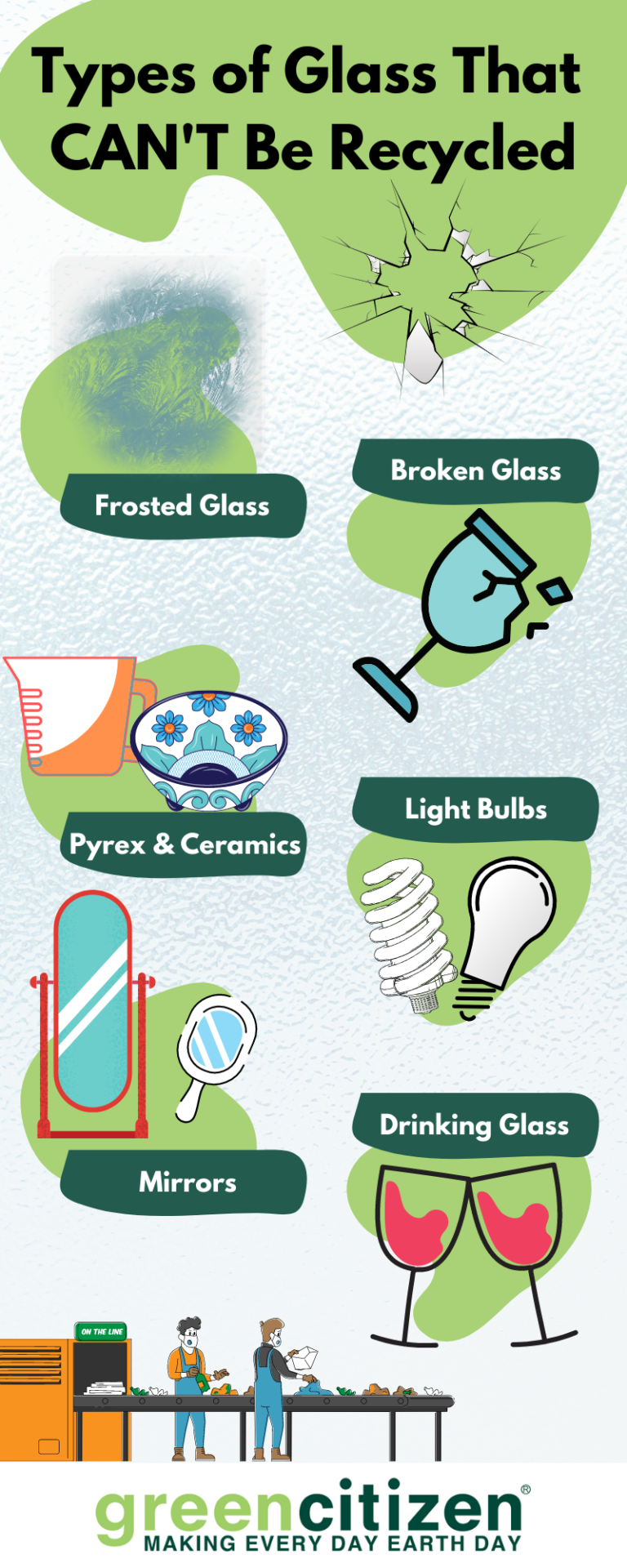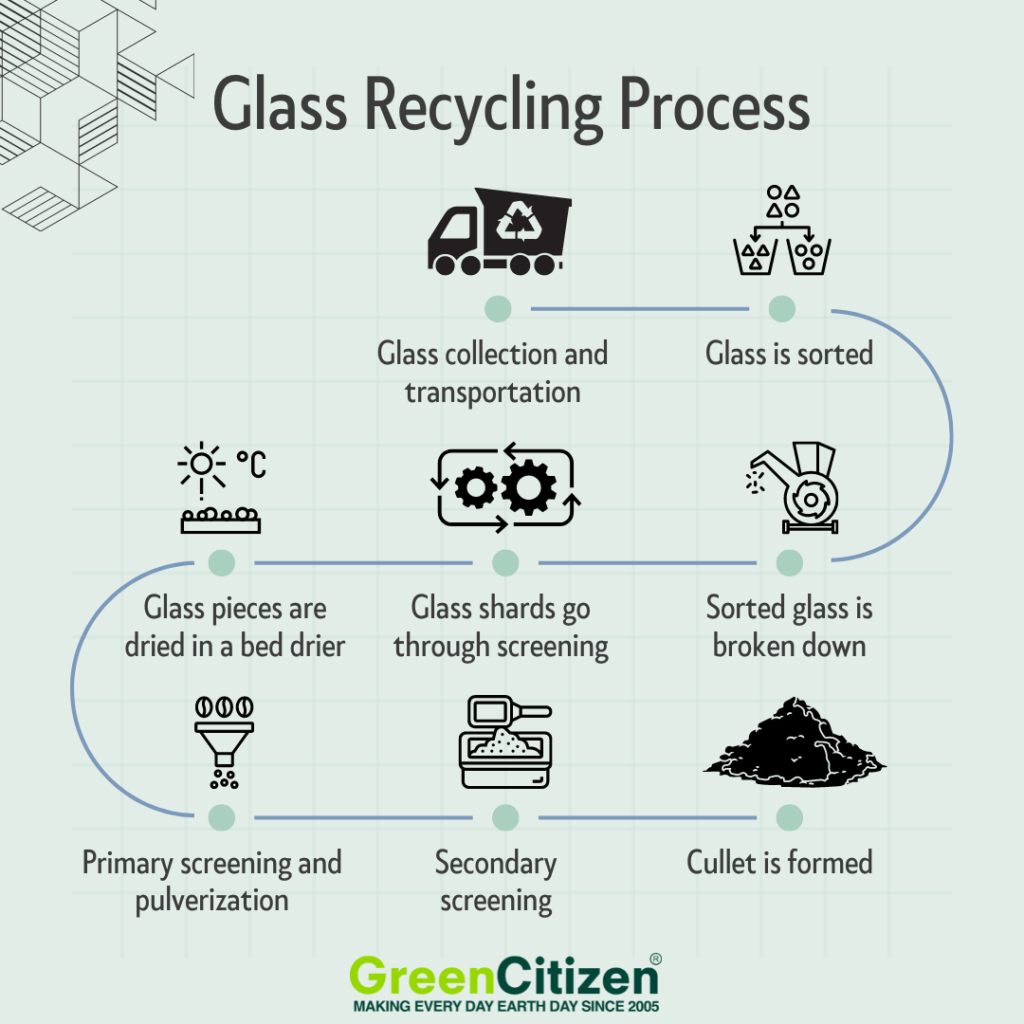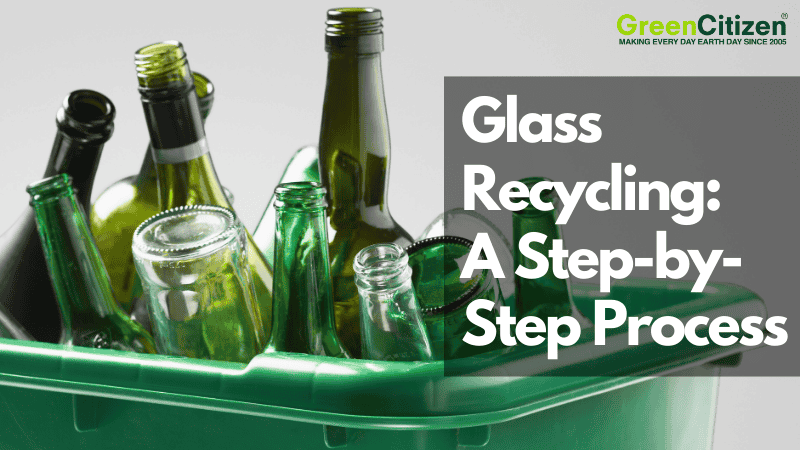Glass recycling is the process of turning used bottles and jars into new glass products — over and over again, without losing quality. Unlike many materials, glass can be recycled endlessly, making it one of the most sustainable packaging options available today.
When you recycle glass, you reduce the need for raw materials like sand and limestone, cut energy use, and help lower greenhouse gas emissions.
But despite its potential, Americans generate over 12 million metric tons of glass waste each year — and only about one-third of it gets recycled. The rest ends up in landfills, where it doesn’t break down.
Recycling glass isn’t complicated — and the impact is huge. In this guide, we’ll explore which types of glass can be recycled, how to do it correctly, and where to find recycling options near you.
Final Takeaway: Why and How to Recycle Glass
Glass is 100% recyclable and can be reused endlessly without losing quality. To ensure it gets recycled properly, rinse containers, remove lids, and follow local recycling rules. If curbside pickup isn’t available, use a certified drop-off site. Recycling glass conserves resources, reduces pollution, and keeps waste out of landfills.
Is Glass Recyclable?
Yes — glass is 100% recyclable and can be recycled endlessly without losing quality, strength, or purity. Most household glass containers — like bottles and jars — can be collected, crushed into cullet, melted, and reshaped into new products in a continuous loop.
Recycling glass helps:
- Save 1.2 tons of raw materials (like sand, soda ash, and limestone) per ton of glass recycled
- Cut CO₂ emissions by about 580 kg
- Reduce air pollution by 20% and water pollution by 50%
Unlike plastic or paper, glass doesn’t degrade after recycling, which means your old soda bottle could become part of a new jar without any drop in quality.
Glass isn’t just recyclable — it’s built for recycling. Every bottle you put in the right bin keeps valuable materials in use and pollution out of the environment.
Which Types of Glass Can and Can’t Be Recycled?
Not all glass is created equal — and not all of it belongs in your recycling bin. Most bottles and jars can be recycled curbside, but specialty glass like mirrors, cookware, or light bulbs often require special handling or cannot be recycled at all.
✅ What Types of Glass Can Be Recycled
Most container glass is accepted in household recycling programs. This includes:
- Glass bottles (clear, green, brown)
- Glass jars (for sauces, jams, condiments)
- GL-coded glass:
- GL-70: clear glass
- GL-71: green glass
- GL-72: brown glass
These are made from similar materials and melt at the same temperature — making them easy to process together.
❌ What Types of Glass Can't Be Recycled
The following types of glass are not recyclable through curbside bins:
- Window glass and mirrors
- Ovenware, cookware, and ceramics
- Tempered or safety glass (car windows, shower doors)
- Light bulbs (especially fluorescent — require special disposal)
- Pyrex and other heat-resistant glass
These items have different chemical compositions, treatments, or melting points that can damage equipment or contaminate entire glass batches.
Why Some Glass Can’t Be Recycled
Recycling facilities are designed to handle standard container glass, which melts uniformly.
Specialty glass — like Pyrex, ceramics, or leaded crystal — is chemically different and doesn’t melt at the same temperature. Even a small amount mixed in can ruin a whole batch of recycled glass.
Most glass bottles and jars are recyclable, but items like ceramics, Pyrex, mirrors, and light bulbs are not. Always check your local recycling guide to avoid contamination.

Does Glass Go in the Recycle Bin?
Yes — in most cities, clean glass bottles and jars can go in your recycling bin. But not all glass is accepted, and some areas no longer collect glass curbside due to processing costs or contamination issues.
To make sure your glass actually gets recycled, here’s what you need to know:
Glass you can usually put in the bin:
- Food jars (pasta sauce, peanut butter, pickles)
- Beverage bottles (wine, beer, juice, soda)
- Clear, green, or brown container glass
Glass you should keep out of the bin:
- Window glass and mirrors
- Ovenware, cookware, and ceramics
- Tempered or safety glass (car windows, shower doors)
- Light bulbs (especially fluorescent — require special disposal)
- Pyrex and other heat-resistant glass
Check Your Local Recycling Rules
Not all curbside recycling programs accept glass. Some cities require residents to take it to a designated drop-off location. Check your municipality’s website to find out what’s accepted near you.
Why the restrictions? These items are made with different materials or coatings, and they melt at different temperatures. If mixed with regular container glass, they can cause defects in new products.
Tip: Always rinse containers before recycling to remove food or liquid residue, and check your local recycling guidelines. Not every community processes glass the same way.
How to Recycle Glass at Home: Step-by-Step for Bottles and Jars
Recycling glass at home is easy — but doing it right ensures your efforts actually count. Follow these simple steps to keep your glass waste out of landfills and back into circulation.
1. Empty and Rinse Thoroughly
Before tossing a glass jar or bottle into the bin, rinse out any food or liquid residue. Dirty glass can contaminate entire loads of recyclables.
2. Remove Lids, Caps, and Extras
Take off metal caps, corks, or plastic lids. These go in the trash or are recycled separately (if accepted locally). Labels can usually stay on unless your local recycler says otherwise.
3. Sort Glass by Color (If Required)
Some drop-off centers request separation into clear, green, and brown glass. If you’re using curbside bins, follow your city’s specific guidelines.
4. Pack Glass Safely for Transport
If you’re dropping off glass at a recycling center, use a sturdy box or bin. Never use plastic bags — they’re not recyclable and can damage sorting equipment.
5. Use the Right Bin or Center
Check whether your curbside program accepts glass. If not, search for a nearby glass recycling drop-off location using your city’s site or GreenCitizen’s Green Directory.
6. Keep Non-Recyclable Glass Out
Do not include:
- Ceramics, Pyrex, or ovenware
- Light bulbs or glassware
- Mirrors, windows, or broken glass
These don’t melt at the same temperature and can contaminate entire batches of recyclables.
Summary: Glass Recycling at Home
To recycle glass at home, rinse containers, remove lids, sort by color if needed, and follow local recycling rules. Clean, sorted glass has the best chance of being recycled properly.
Where to Recycle Glass Near Me: Find a Drop-Off or Curbside Option
Looking to recycle glass bottles, jars, or containers? Your options depend on where you live — some cities accept glass in curbside bins, while others require you to use a designated drop-off center.
Here’s how to find a reliable location near you:
1. Check Your City’s Recycling Program
Start with your municipality’s website. Many local waste departments have a recycling guide or interactive map that shows whether glass is accepted in your curbside bin — and what types.
2. Try Local Retail or Redemption Centers
In states with bottle deposit laws — like California, Michigan, or Oregon — grocery stores, beverage redemption centers, or depots may accept glass bottles for recycling or refund.
3. Use a Glass Recycling Locator Tool
The easiest way to find a certified recycler near you is to use GreenCitizen’s Green Directory. It allows you to search by material type and location, so you can find exactly what you need — whether it’s for clear, green, brown, or even blue glass.
Here’s how to use the Green Directory to recycle glass near you:
- Go to GreenCitizen’s Green Directory
- In the “Search for” field, type “glass” — or get specific with “glass bottles,” “glass jars,” or “clear glass”
- In the “Location” field, enter your city, zip code, or preferred drop-off area
- (Optional) Set your preferred distance: 5, 10, 25, 50, or 100 miles
- Click Search and browse the list of verified recyclers near you
Whether you’re looking for local drop-offs or eco-friendly services within your ZIP code, the Green Directory can help you find the most convenient option.
⚠️ Note: Skip Public Recycling Bins!
Most public-area recycling bins don’t accept glass unless labeled clearly. If in doubt, keep it out.
How Is Glass Recycled? Step-by-Step Breakdown of the Glass Recycling Process
Glass is one of the few materials that can be recycled endlessly — but it has to go through a careful process to be reused correctly.

Here’s how your bottles and jars are turned into new products:
1. Collection and Transportation
Glass is collected from curbside bins, drop-off points, and businesses, then transported to specialized recycling facilities.
2. Sorting by Material and Color
At the facility, optical scanners and magnets remove non-glass items like metals, plastics, and contaminants. The glass is also sorted into clear, green, and brown, since mixing colors can affect quality.
3. Crushing the Glass
Powerful crushers break the sorted glass into small fragments. Water is sprayed to reduce dust during the crushing process.
4. Rotary Screening and Label Removal
Glass fragments pass through rotating screens that sort by size. A fan system removes leftover paper labels and light debris.
5. Thermal Cleaning (Agitation Drying)
The crushed glass is dried with hot air in a shaking bed. This removes sugars, bacteria, and sticky residues using heat and suction.
6. Primary Screening and Pulverization
Glass that’s too large passes through a mesh screen and is sent to a pulverizer, which breaks it down further.
7. Secondary Screening
The glass is screened again to sort it into precise sizes needed for different applications.
8. Cullet Creation
The final product is cullet — small, clean, uniform glass particles ready to be melted into new bottles, fiberglass, tiles, abrasives, and more.
The glass recycling process transforms used bottles into cullet — a clean, reusable material that reduces pollution, saves raw resources, and keeps glass out of landfills.
Why Is Glass So Hard to Recycle? Challenges Facing the U.S. Recycling System
Despite being 100% recyclable, over 60% of glass in the U.S. ends up in landfills. In fact, Americans dispose of an estimated 28 billion glass bottles per year, where they take between 4,000 to 1 million years to decompose.
So why isn’t more glass being recycled?
Major Challenges in U.S. Glass Recycling
1. Single-Stream Contamination
Most U.S. cities use single-stream recycling — where all recyclables (plastic, metal, paper, glass) are mixed in one bin. This leads to:
- Glass contamination from food or non-recyclable items
- Broken shards mixing into paper or plastic
- Higher processing costs for sorting and cleaning
2. High Collection and Transport Costs
Glass is heavy. Trucks make more trips and burn more fuel, making it costly compared to plastic or aluminum.
3. Low Market Value
The U.S. glass market is flooded with low-value cullet. Meanwhile, demand for plastic and aluminum has surged, leaving recycled glass with fewer buyers.
4. Color Sorting and Quality Control
Broken glass from curbside bins makes it difficult to sort by color. Without proper sorting, the recycled product is too impure for manufacturing.
5. Safety and Machinery Issues
Broken glass poses injury risks to workers and damages equipment — especially when mixed with other materials.
💡 Glass is endlessly recyclable, but in the U.S., contamination, transport costs, and weak market demand make glass one of the most difficult materials to recycle effectively.
Solutions: How to Improve Glass Recycling
1. Container Deposit Legislation (CDL)
States with deposit programs (e.g., CA, MI) see glass recycling rates of over 63%, compared to just 24% in states without them. Refund incentives drive consumer participation.
2. Switch to Multi-Stream Recycling
Multi-stream programs — where consumers sort materials before collection — lead to 90% glass recycling rates in Europe. These programs reduce contamination and produce cleaner cullet.
3. Invest in Consumer Education
Teaching people what does and doesn’t go into the bin can drastically reduce contamination and increase the effectiveness of existing systems.
The U.S. glass recycling system isn’t broken — it’s mismatched. With stronger legislation, cleaner collection systems, and better consumer guidance, glass can become a circular success story.
Is Glass Bad for the Environment? Environmental Impact of Glass Waste
Although glass is endlessly recyclable, it often ends up in landfills — where it becomes a long-term environmental threat. In the U.S., up to 75% of glass waste is never recycled, even though it could be reused indefinitely.
What Happens When Glass Goes to Landfills?
- Americans send 28 billion glass bottles and jars to landfills every year.
- That’s more than 110,000 bottles every day — most of which take up to a million years to decompose.
- Glass doesn’t biodegrade — it simply piles up, leaching into ecosystems.
Environmental Consequences
- Toxic metals in glassware — items like decorated or enameled drinking glasses can contain:
- Up to 1,000× the legal lead limit
- Up to 100× the cadmium limit
- These toxins can leach into soil and water or harm wildlife upon exposure.
- Broken glass in landfills injures animals and can transmit contaminants through cuts or punctures.
Wasted Resources
Glass manufacturing requires:
- Rare raw materials like silica, limestone, and soda ash
- Fossil fuels for melting and transport
When glass isn’t recycled, all these inputs are wasted — and replaced with more mining and more emissions.
A study from the University of Southampton even suggests that, depending on its life cycle, glass may be worse than plastic in terms of environmental impact — especially when it’s landfilled.
Although recyclable, most glass ends up in landfills, where it can take thousands of years to break down, harm wildlife, and waste valuable resources.
Is It Better To Reuse Or Recycle Glass?
Recycling is always an excellent option, no matter if you need to recycle glass, an old printer, microwave, TV, or some other electronics.
Glass recycling has several benefits:
- A ton of recycled glass saves over a ton of natural resources.
- For every 10% of used cullet, energy cost goes down 2 to 3 %.
- 6 tons of recycled glass reduce a ton of carbon dioxide used in the manufacturing process.
- Cullet melts at a lower temperature, so it uses less energy.
- Glass made from recycled glass reduces air pollution by 20% and water pollution by 50%.
However, glass recycling is becoming more difficult to perform, as recyclers are starting to refuse these jobs.
In this case, you should reuse glass. Reusing glass uses even fewer resources than glass recycling.
Frequently Asked Questions (FAQ)
Yes, glass can be recycled. Glass is 100% recyclable, it can be recycled endlessly, and it won’t lose quality or purity.
Yes, glass recycling is profitable. Data from 2014 shows that the glass recycling industry employs more than 1.1 million people and has $236 billion in gross revenue. However, because a lot of manufacturers are stepping away from glass bottle production, municipalities are removing glass recycling programs due to the lack of demand.
Glass waste can be reused in an infinite number of ways. Glass bottles can be used as vases, soap dispensers, in a bird feeder, and more. Drinking can be turned into floral displays, and jars can be used for storage.
A glass bottle takes 4,000 to a billion years to decompose in a landfill.
When glass decomposes, the surface of the glass absorbs moisture, which results in devitrification — the outer layer crystalizes and flakes off, which results in an iridescent appearance. Because glass is made with a very stable formula, glass in landfills only goes through a slight devitrification.
Yes, glass is eco-friendly. It’s made of natural ingredients, so it doesn’t release harmful chemicals into the soil when it breaks down.
Glass Recycling Starts With You: Make the Smarter Choice
Glass is one of the most sustainable materials we use — but only if it’s recycled or reused properly. While the U.S. still struggles with glass recycling rates, every clean bottle you recycle helps cut waste, save resources, and reduce emissions.
Not sure where to take your glass? Use the GreenCitizen Green Directory to find drop-off points or certified recyclers near you.
And if recycling isn’t available in your area, consider reusing glass containers creatively at home. Small choices scale up when we make them together.
Let’s stop sending glass to landfills. Let’s keep it in the loop.


